Pics of Easy to Draw Leopards Pics of Easy to Draw Leopards
One of the biggest cats in the world, leopards are known for their characteristic spotted coat. Despite their close resemblance to our household cats, you do not want to get up close and personal with these majestic predators. What better way is there of celebrating these wonderful big cats than by drawing them? In this easy-to-follow leopard drawing tutorial, we help you create a realistic leopard painting in a few simple steps.
Table of Contents
- 1 A Realistic Step-by-Step Leopard Drawing Tutorial
- 1.1 Step 1: Create the Main Body Shape
- 1.2 Step 2: Drawing the Leopard's Head
- 1.3 Step 3: Creating the Shape of the Leopard Face Drawing
- 1.4 Step 4: Connecting the Leopard's Head and Body
- 1.5 Step 5: Shaping the Leopard's Hindquarters
- 1.6 Step 6: Constructing the Leopard's Front Legs
- 1.7 Step 7: Drawing the Leopard's Back Legs
- 1.8 Step 8: Constructing the Leopard's Tail
- 1.9 Step 9: Drawing the Final Leopard Outline
- 1.10 Step 10: It Is Time to Draw Leopard Spots
- 1.11 Step 11: Adding the First Coat of Color
- 1.12 Step 12: Shading to Create Dimension
- 1.13 Step 13: Laying Down the Second Color
- 1.14 Step 14: Adding Some Additional Shading
- 1.15 Step 15: Adding Final Colored Details
- 1.16 Step 16: Finishing up Your Leopard Drawing
- 2 Video Tutorial on How to Draw a Leopard
- 3 Frequently Asked Questions
- 3.1 How do You Draw Leopard Spots?
- 3.2 Is Leopard Drawing Complicated?
A Realistic Step-by-Step Leopard Drawing Tutorial
If you looked at the thumbnail of this tutorial and thought that you could not possibly draw such a realistic leopard on your first try, then, fortunately, you are wrong! We have designed our leopard drawing tutorial in such a way that any artist of any level can easily create a realistic drawing of this big cat. We begin our tutorial with 8 construction steps that will help you lay down the shape of your leopard before you begin adding detailing, texture, and color. Take a look at the step summary below.
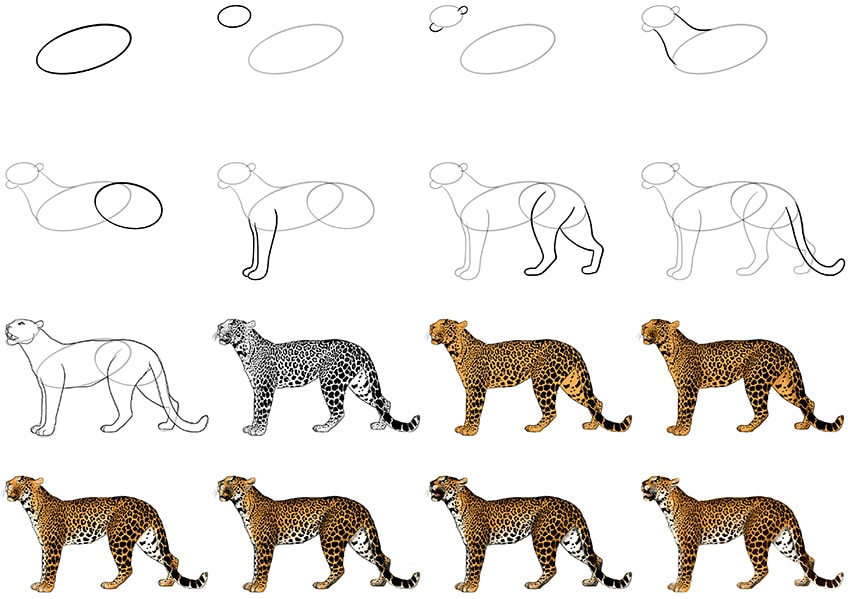
When we get to the later steps where you begin adding color, the question of the medium comes into play. The tutorial is written in terms of a physical paint medium, but the coloring steps are adaptable to a range of different mediums.
So whether you are a graphic artist or you prefer to work with coloring pencils, you can easily follow this tutorial and create a beautiful and realistic leopard drawing.
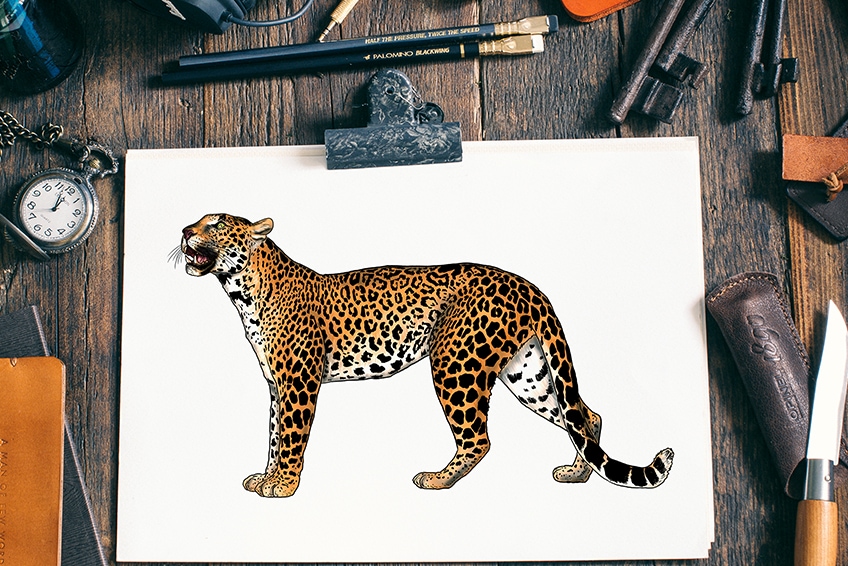
Step 1: Create the Main Body Shape
To begin your leopard drawing construction, you are going to lay down the general shape of the largest part of the leopard's body. To do this, you are going to use a narrow elongated oval to represent the main body shape. Your main body oval should be slightly tilted with the right side being higher than the left.
As you begin this first step, make sure that your oval is in the very center of your canvas, leaving plenty of space for the leopard's head, legs, and tail.
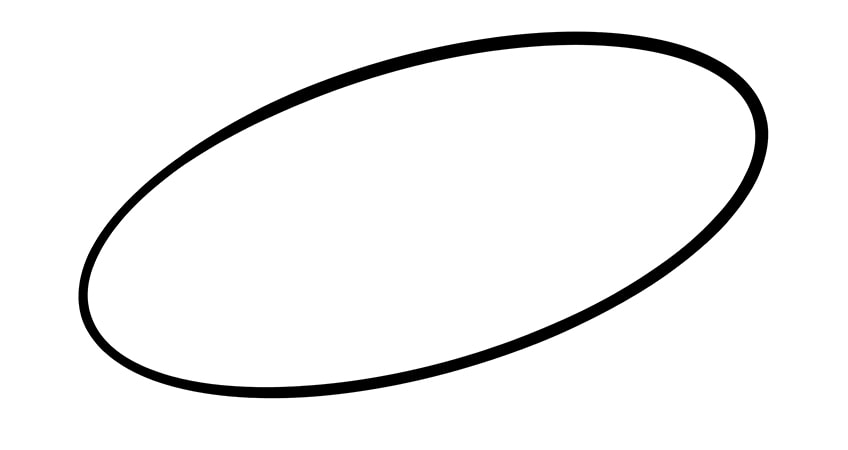
Step 2: Drawing the Leopard's Head
For the head shape, you are going to use another oval shape as the base. The head oval should be much smaller than the main body, and slightly less tilted.
Place the head oval on the far left side of the canvas, just above the highest point of the main body oval.

Step 3: Creating the Shape of the Leopard Face Drawing
In this step, you are going to create the shape of the ear and carve out the lower jaw of your leopard face drawing. Begin on the top of the head oval, by drawing a small incomplete oval to represent the leopard's ear. Next, at the bottom left side of the head oval, draw a slightly bigger incomplete oval shape.
This lower oval shape will represent the lower jaw line that we will use to shape the mouth in later steps.
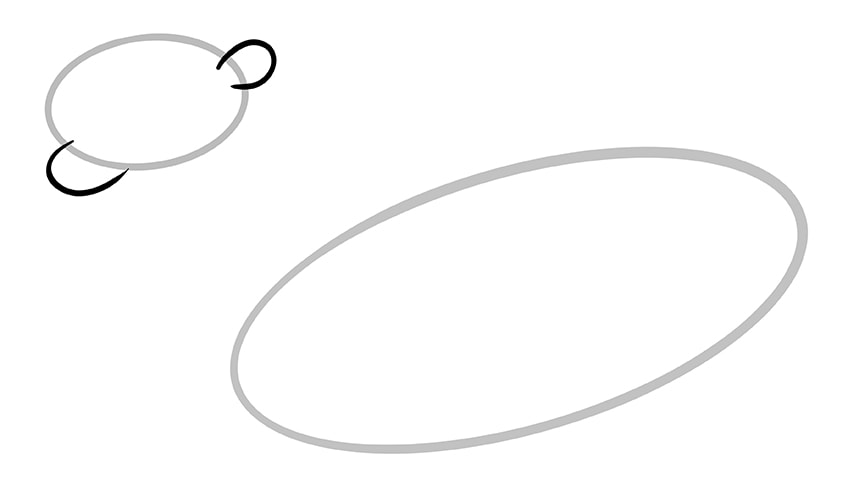
Step 4: Connecting the Leopard's Head and Body
In this step, you are going to use the leopard's neck to join the head and body construction shapes. Begin with the upper neckline, starting from the bottom of the ear shape and curving down to meet the top of the main body oval.
For the bottom neckline, repeat the process beginning below the jaw shape and ending at the front point of the main body oval.

Step 5: Shaping the Leopard's Hindquarters
If you take a look at the final drawing example, you will see that the leopard's back slopes down. Before this step, the back of the leopard was raised compared to the chest area. In this step, you are going to draw another slightly smaller oval shape that tilts in the opposite direction to the main body oval.
This back body oval should overlap the main body oval quite a lot.
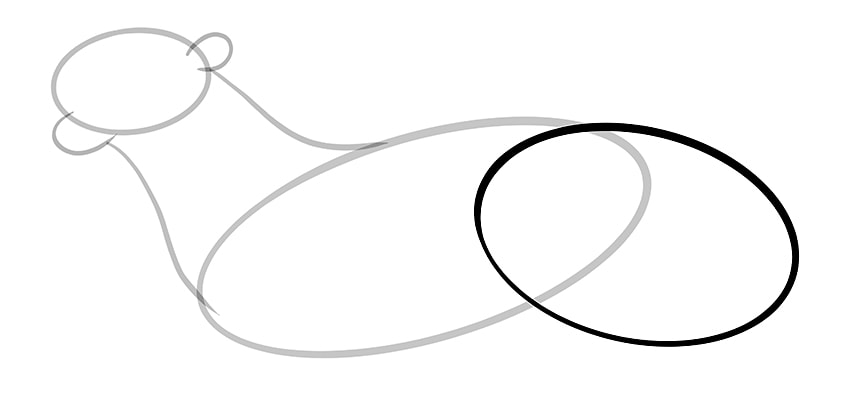
Step 6: Constructing the Leopard's Front Legs
When it comes to drawing the leopard's legs, perspective is the most important consideration. Because we are viewing the leopard from side-on, the leg that is closest to us will obstruct the leg behind it. This is where construction lines shine because they can help us nail this perspective easily. Begin with the leg that is closest to us, taking a line down from within the main body oval. At the bottom of this line, create a curved paw and then bring the line back up to meet the main body oval line.
For the second leg, simply draw the front part of the leg beginning at the tip of the main body oval.
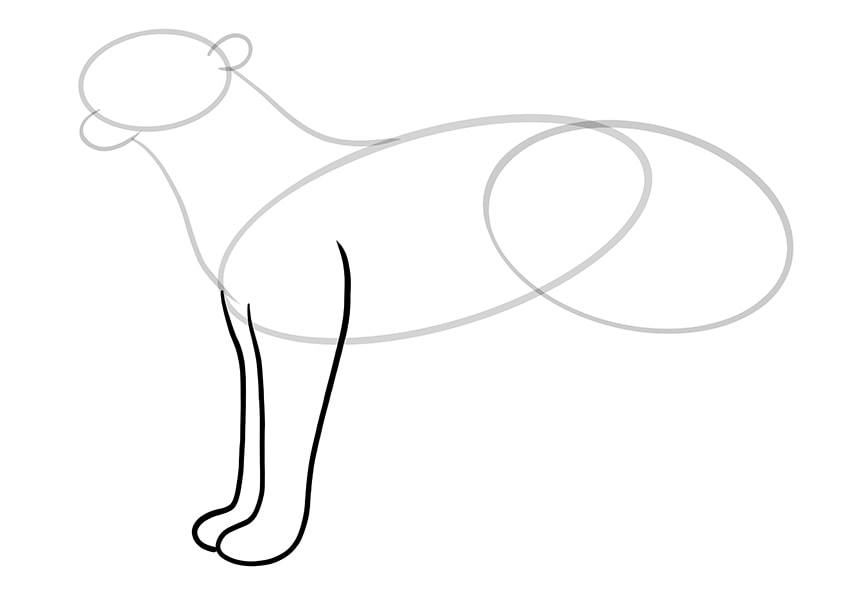
Step 7: Drawing the Leopard's Back Legs
The back legs of your leopard drawing are quite different in shape from the front legs. They are also separated as the leopard is moving. Let us begin, again, with the leg that is closest to us. Start the leg line within the overlap between the main body and back body ovals. Curve the leg line forwards and down, before creating a foot shape and then bringing the leg back up into the rear body oval. For the second leg, create a similarly shaped leg that is angled backward.
The second leg lines should begin at the intersection of the first leg and the rear body oval and end just above the back point of this oval.
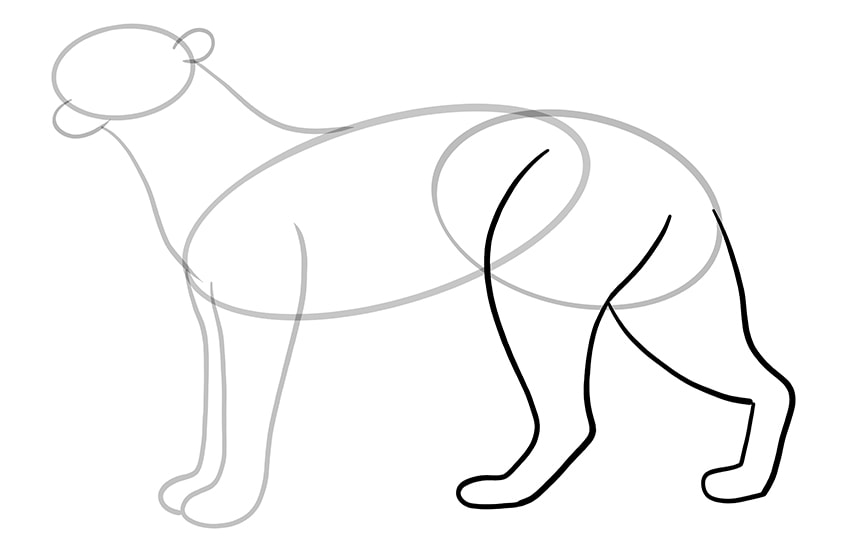
Step 8: Constructing the Leopard's Tail
In our last construction step, you are going to create the shape of the leopard's tail. Use a curved line that begins from the point where the back leg touches the rear oval.
Bring the line down and twist it up at the end, before curving it back to join the end of the other leg line within the rear body oval.

Step 9: Drawing the Final Leopard Outline
Now that we have laid down the basic shape of our leopard drawing, it is time to bring it all together and create the final outline. Begin with the head, following the construction shape but also adding a few lumps and bumps to make it more realistic. Draw in the nostril slope and add in a strong jawline within the neck construction.
Complete your head outline by drawing the central point of the mouth, making it appear to be open. Add some teeth details and draw in the leopard's nose and eye.
Below the ear, continue to follow the construction lines across the leopard's back and down around the tail. For the most part, you can follow the construction lines very closely. On the back of the hind legs and the bottom of the tail, use short little lines to create a fur-like texture. For the feet, create toe separations on the round pads.
Once you have finished your outline, you can erase all the remaining construction lines.
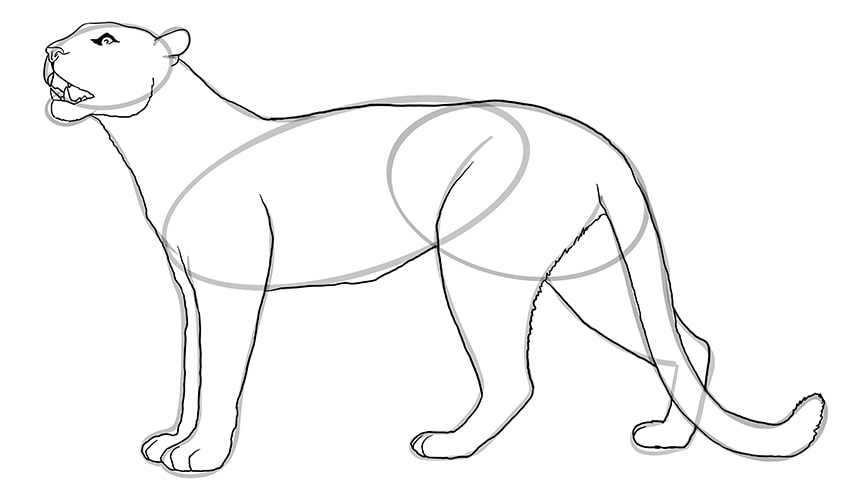
Step 10: It Is Time to Draw Leopard Spots
It has now come time to draw leopard spots, the most characteristic feature of this beautiful big cat. Begin by adding texture to the leopard face drawing. Around the nose, add a series of dots and then some long whiskers. Add some black color around the bottom jaw, and scribble a few lines to create a bearded texture. As you begin to move towards the back of the head and down the neck, you can start drawing scribbled patterns.
The further towards the back and bottom of your leopard drawing you get, the larger these black spots should be.
When you draw leopard spots around the edge of the body, make them more curved to give the impression of them wrapping around the leopard's body. Finish this step by adding small line strokes around the toes and within the leopard's ears.
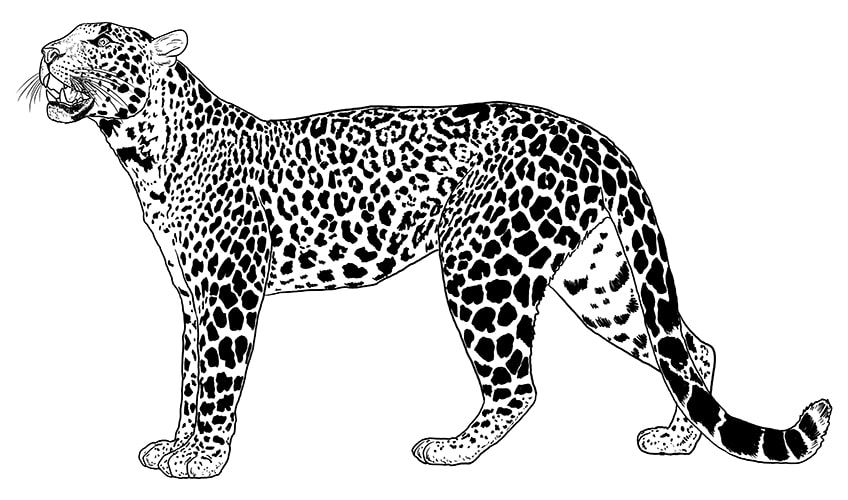
Step 11: Adding the First Coat of Color
To get a realistic color on the leopard's coat, we are going to build it up in a few different layers. We begin with the base coat of a light brown shade.
Regardless of the color medium that you are using, you want to ensure that this base coat is even throughout the leopard's body.
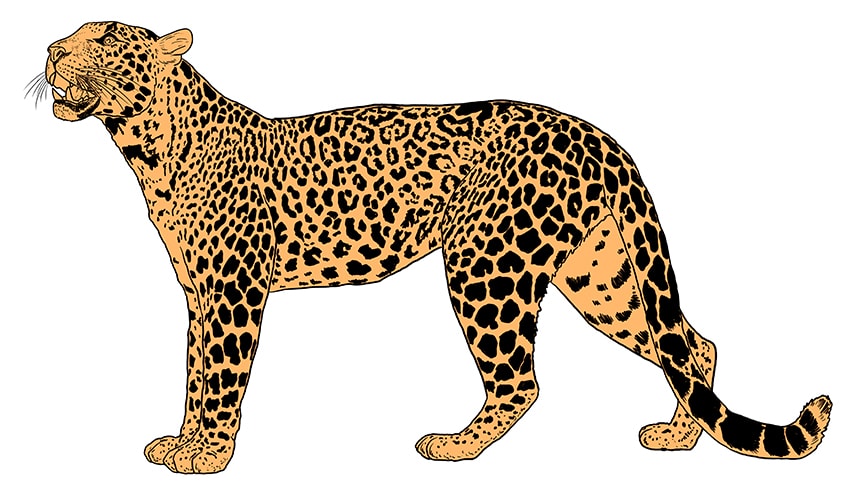
Step 12: Shading to Create Dimension
In this step, you are going to use a light touch of black to create shading throughout the leopard's body. Use a soft brush so that you can blend the paint well, and add a small amount of black to the mains structure of the leopard.
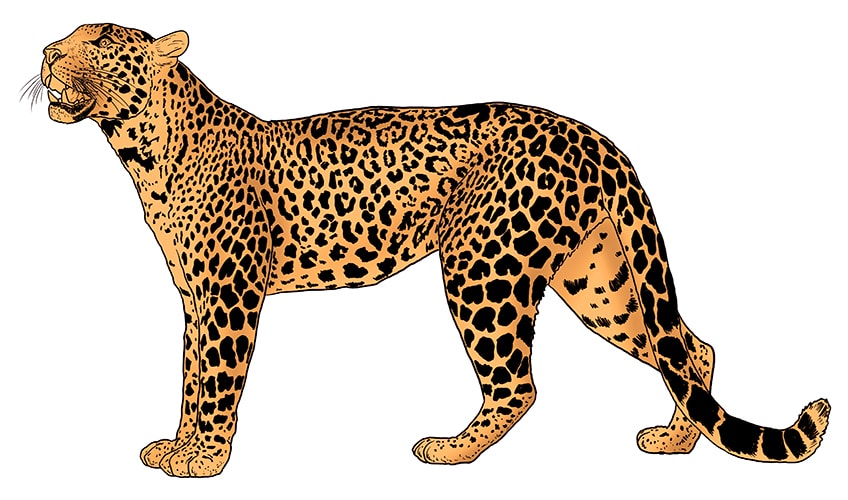
The image below shows where you should place this shading, along the tail, rear legs, front legs, neck, back, and head. Simply follow the green lines.

Step 13: Laying Down the Second Color
The second color we are going to add to our leopard drawing is white. Choose a soft blending brush and add a coat of white paint to the inner thigh of the rear thigh and along the bottom edge of the tail. Next, use the white shade to color the leopard's chest, lower chin, along the front leg, and on the belly.
Finally, finish this step by adding another layer to the inner thigh and cheek area.
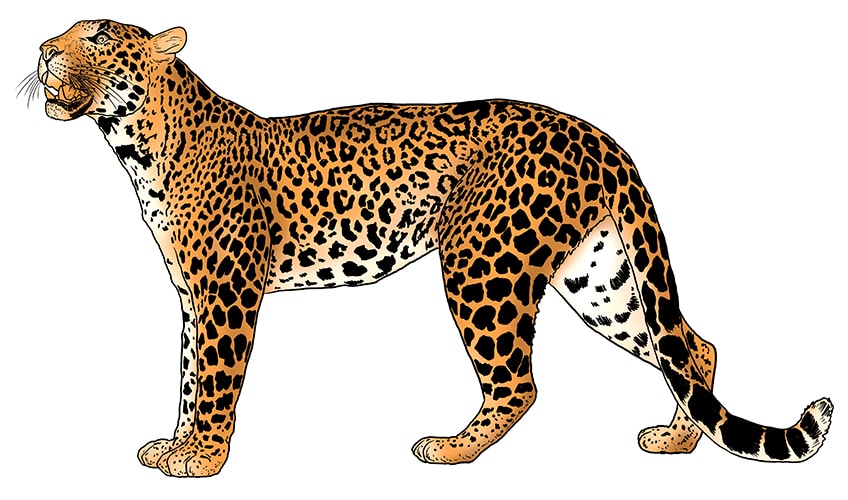
Step 14: Adding Some Additional Shading
In this step, we are going to add some additional shading to emphasize the shape and proportions of the leopard's body. Once again, use a soft blending brush with a touch of black paint to shade around the leopard's face and around the outline of the leopard's body as a whole. Trace any textures, like the toe lines and creases above the legs with black to add definition.
Finally, add a touch of shadow within the ear to create a more three-dimensional impression.
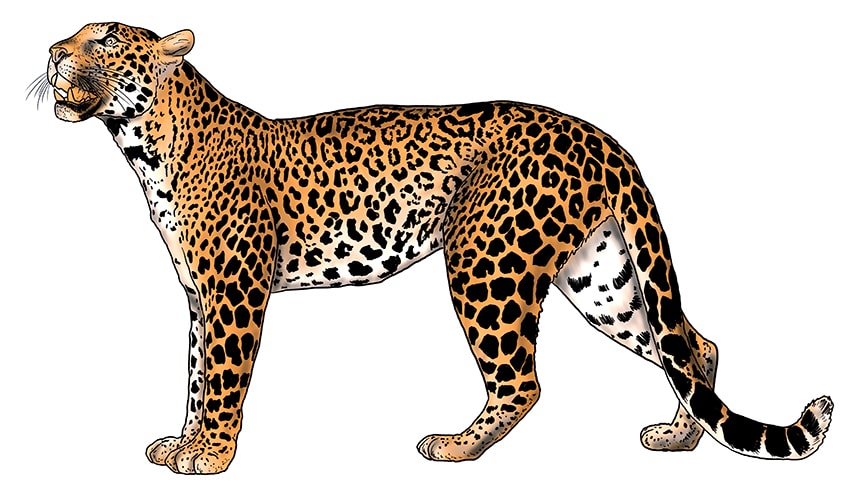
Step 15: Adding Final Colored Details
In this second last step, you are going to add some final coloring details to the leopard face drawing and the rest of its body. Begin by using a bright green shade and a small brush to fill in the leopard's eye. To finish the eye detail, add a dot of white in the very center. Next, use a light pink shade to color the inside of the mouth and the nostrils. Finish the leopard face drawing by using a touch of black to shade the mouth, nostrils, and inner ear.
Next, use the same soft brush and a little white paint to the areas around the face, emphasizing the eyes, whiskers, ear, and jaw.
Finally, finish the face details by using white to color the teeth. For the finishing touches, add little dabs of white paint between the patterns starting on the neckline and fading up from the belly.

Step 16: Finishing up Your Leopard Drawing
This final step is optional but helps create a seamlessly finished drawing. What you need to do is simply erase the outlines of your drawing. You can do this in one of two ways, depending on the medium you have used. If you work on a graphic tablet, then you can simply remove the outline layer. If you are working with a more physical medium, then you can simply trace over the outlines with the corresponding color at each point.

Well done for successfully creating a realistic leopard drawing. You have learnt how to draw leopard spots and how to achieve realistic coloring. Hopefully we will see you again soon for another drawing!
Video Tutorial on How to Draw a Leopard
Frequently Asked Questions
How do You Draw Leopard Spots?
Leopard spots are not actually round circles but rather a small half-moon with a little spot inside. In our tutorial, we show you exactly how to draw leopard spots in a realistic way.
Is Leopard Drawing Complicated?
As with all animals, it can be daunting to jump right in and begin drawing. For this reason, we always begin our tutorials with a series of construction steps. These construction lines and shapes help us plan out the final outline of our leopard drawing, making it much more simple to draw.
holbrookpeatchath.blogspot.com
Source: https://artincontext.org/how-to-draw-a-leopard/

0 Response to "Pics of Easy to Draw Leopards Pics of Easy to Draw Leopards"
Post a Comment